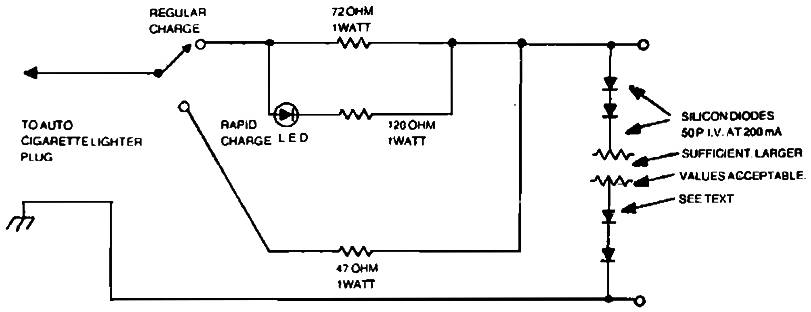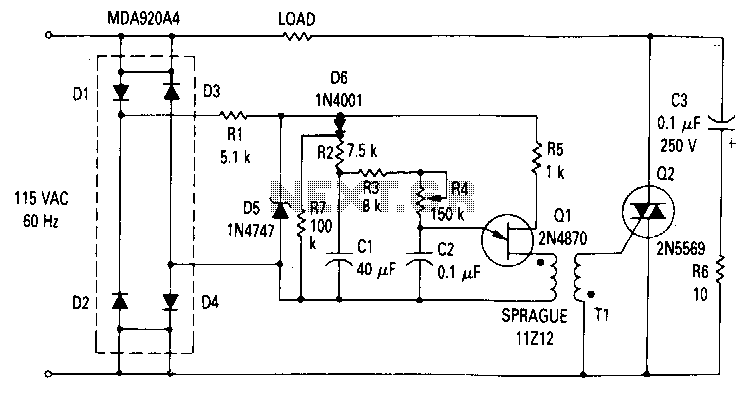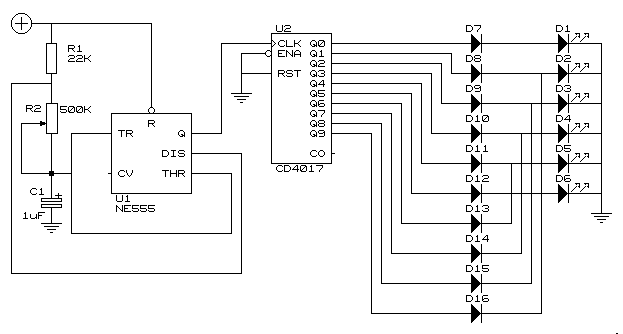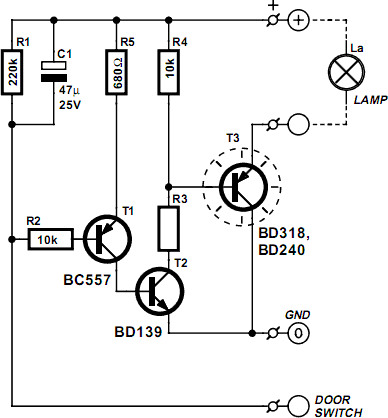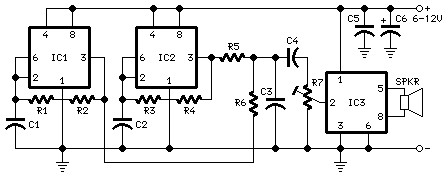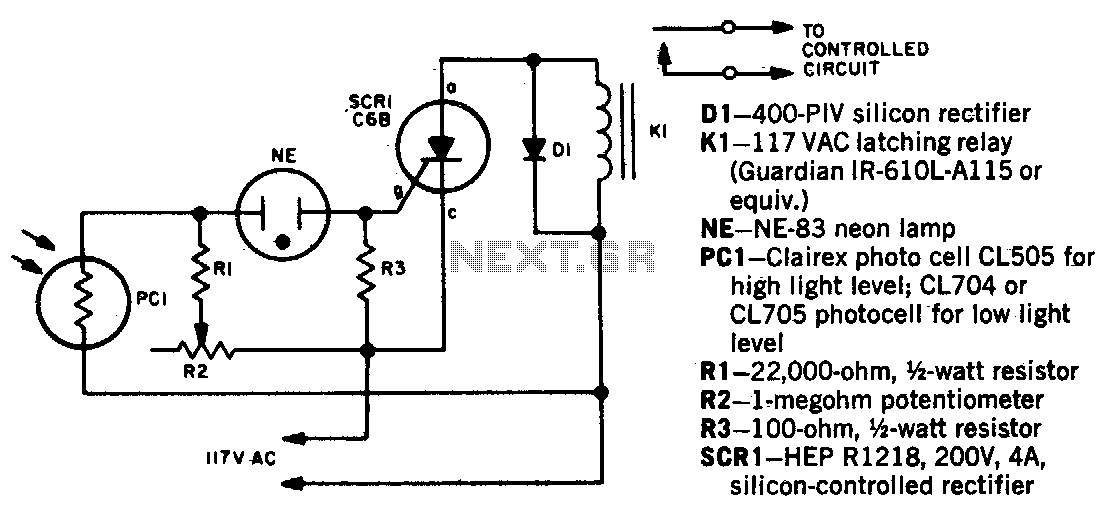
Car Boot Light Warning
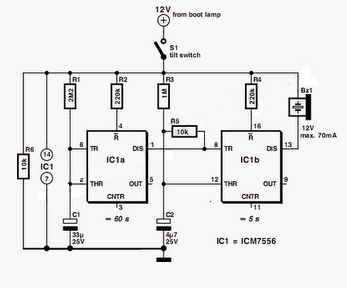
In many vehicles, the boot light remains illuminated until the lid is securely closed. It is common to accidentally leave the lid slightly ajar while unloading the car. If the vehicle is not used for an extended period, this oversight can lead to a drained battery, resulting in difficulties when attempting to start the car. The circuit described herein provides a warning system for such situations. A mercury tilt switch is positioned in the boot so that its contacts close as the lid is lowered, before it is fully shut. The circuit receives power from the switched 12V supply to the boot lamp, passing through the mercury switch. When the lid is properly closed, the boot lamp turns off, cutting off power to the circuit. However, if the lid is left ajar, the lamp remains on, and the mercury switch closes the circuit. After a delay of five seconds, an alarm will activate and continue for one minute unless the lid is closed, serving as a reminder to secure the boot. This one-minute duration prevents the alarm from sounding continuously when transporting larger items that may prevent the boot from closing fully. The circuit utilizes a dual CMOS timer, specifically the type 7556 (the bipolar 556 version is not suitable). Upon power application (when the boot lid is ajar), tantalum capacitors C1 and C2 ensure that the timer outputs remain high. Approximately five seconds later, when the voltage across C2 reaches two-thirds of the supply voltage, timer IC1b is triggered, causing the alarm to sound. Concurrently, the voltage across C1 rises at a slower rate, reaching two-thirds of the supply voltage after about one minute, which triggers IC1a and resets IC1b, silencing the alarm. IC1a will maintain this state until the boot lid is either closed or opened wider, at which point C1 and C2 will discharge through resistor R6, preparing the circuit for another cycle. The timer period can be calculated using the formula: t = 1.1RC. It is important to note that tantalum or electrolytic capacitors with solid electrolytes should be used in the circuit, and the buzzer must be suitable for DC operation, featuring a built-in driver.
The schematic circuit described incorporates several key components and functionalities designed to prevent battery drain due to an ajar boot lid. The mercury tilt switch acts as a primary sensor, detecting the position of the boot lid. When the boot is closed, the switch opens, interrupting the circuit and ensuring that the alarm system is inactive. Conversely, if the lid is left open, the switch closes, allowing current to flow through the circuit.
The dual CMOS timer IC (7556) plays a crucial role in timing the alarm activation. It is configured in a monostable mode where the first timer (IC1a) is responsible for resetting the second timer (IC1b) after a predetermined duration. The capacitors C1 and C2 are essential for establishing the timing intervals. The values of these capacitors, along with the resistance of R6, can be adjusted to fine-tune the timing characteristics of the alarm system.
The alarm itself is activated by the output of IC1b, which drives a buzzer designed for DC operation. This buzzer emits an audible signal when triggered, alerting the user to the condition of the boot lid. The design ensures that the alarm does not sound continuously for an extended period, providing a reasonable timeout that allows for user intervention without causing undue annoyance.
For practical implementation, it is vital to ensure that the components selected meet the specifications required for automotive applications, particularly in terms of temperature resilience and vibration tolerance. The choice of tantalum capacitors is specifically highlighted due to their reliability and performance in such environments. Proper layout and connections in the circuit design will also contribute to the overall functionality and durability of the system, ensuring that it operates effectively over the lifespan of the vehicle.On many cars, the boot light will not go out until the lid is properly closed. It is all too easy when unloading the car, to leave the lid ajar. If you are unlucky and the car remains unused for some time, the next time you try to start it, the lamp will have drained the battery and you will no doubt utter a few appropriate words. The circuit described here will give a warning of just such a situation. A mercury tilt switch is mounted in the boot so that as the lid is closed, its contacts close before the lid is completely shut. The supply for the circuit comes from the switched 12 V to the boot lamp and through the mercury switch.
When the lid is properly closed, the boot lamp will go out and the supply to the circuit will go to zero. If however the lid is left ajar, the lamp will be on and the mercury switch will close the circuit. After 5 seconds, the alarm will start to sound, and unless the lid is shut, it will continue for 1 minute to remind you to close the boot properly.
The 1-minute operating period will ensure that the alarm does not sound continuously if you are, for example, transporting bulky items and the boot will not fully close. The circuit consists of a dual CMOS timer type 7556 (the bipolar 556 version is unsuitable for this application).
When power is applied to the circuit (i. e. the boot lid is ajar) tantalum capacitors C1 and C2 will ensure that the outputs of the timers are high. After approximately 5 seconds, when the voltage across C2 rises to 2/3 of the supply voltage, timer IC1b will be triggered and its output will go low thereby causing the alarm to sound.
Meanwhile the voltage across C1 is rising much more slowly and after approximately 1 minute, it will have reached 2/3 of the supply voltage. IC1a will now trigger and this will reset IC1b. The alarm will be turned off. IC1a will remain in this state until the boot lid is either closed or opened wider at which point C1 and C2 will be discharged through R6 and the circuit will be ready to start again.
To calculate the period of the timers use the formula: t = 1. 1RC Please note that the capacitor type used in the circuit should be tantalum or electrolytic with a solid electrolyte. The buzzer must be a type suitable for use at D. C. (i. e. one with a built in driver). 🔗 External reference
The schematic circuit described incorporates several key components and functionalities designed to prevent battery drain due to an ajar boot lid. The mercury tilt switch acts as a primary sensor, detecting the position of the boot lid. When the boot is closed, the switch opens, interrupting the circuit and ensuring that the alarm system is inactive. Conversely, if the lid is left open, the switch closes, allowing current to flow through the circuit.
The dual CMOS timer IC (7556) plays a crucial role in timing the alarm activation. It is configured in a monostable mode where the first timer (IC1a) is responsible for resetting the second timer (IC1b) after a predetermined duration. The capacitors C1 and C2 are essential for establishing the timing intervals. The values of these capacitors, along with the resistance of R6, can be adjusted to fine-tune the timing characteristics of the alarm system.
The alarm itself is activated by the output of IC1b, which drives a buzzer designed for DC operation. This buzzer emits an audible signal when triggered, alerting the user to the condition of the boot lid. The design ensures that the alarm does not sound continuously for an extended period, providing a reasonable timeout that allows for user intervention without causing undue annoyance.
For practical implementation, it is vital to ensure that the components selected meet the specifications required for automotive applications, particularly in terms of temperature resilience and vibration tolerance. The choice of tantalum capacitors is specifically highlighted due to their reliability and performance in such environments. Proper layout and connections in the circuit design will also contribute to the overall functionality and durability of the system, ensuring that it operates effectively over the lifespan of the vehicle.On many cars, the boot light will not go out until the lid is properly closed. It is all too easy when unloading the car, to leave the lid ajar. If you are unlucky and the car remains unused for some time, the next time you try to start it, the lamp will have drained the battery and you will no doubt utter a few appropriate words. The circuit described here will give a warning of just such a situation. A mercury tilt switch is mounted in the boot so that as the lid is closed, its contacts close before the lid is completely shut. The supply for the circuit comes from the switched 12 V to the boot lamp and through the mercury switch.
When the lid is properly closed, the boot lamp will go out and the supply to the circuit will go to zero. If however the lid is left ajar, the lamp will be on and the mercury switch will close the circuit. After 5 seconds, the alarm will start to sound, and unless the lid is shut, it will continue for 1 minute to remind you to close the boot properly.
The 1-minute operating period will ensure that the alarm does not sound continuously if you are, for example, transporting bulky items and the boot will not fully close. The circuit consists of a dual CMOS timer type 7556 (the bipolar 556 version is unsuitable for this application).
When power is applied to the circuit (i. e. the boot lid is ajar) tantalum capacitors C1 and C2 will ensure that the outputs of the timers are high. After approximately 5 seconds, when the voltage across C2 rises to 2/3 of the supply voltage, timer IC1b will be triggered and its output will go low thereby causing the alarm to sound.
Meanwhile the voltage across C1 is rising much more slowly and after approximately 1 minute, it will have reached 2/3 of the supply voltage. IC1a will now trigger and this will reset IC1b. The alarm will be turned off. IC1a will remain in this state until the boot lid is either closed or opened wider at which point C1 and C2 will be discharged through R6 and the circuit will be ready to start again.
To calculate the period of the timers use the formula: t = 1. 1RC Please note that the capacitor type used in the circuit should be tantalum or electrolytic with a solid electrolyte. The buzzer must be a type suitable for use at D. C. (i. e. one with a built in driver). 🔗 External reference
